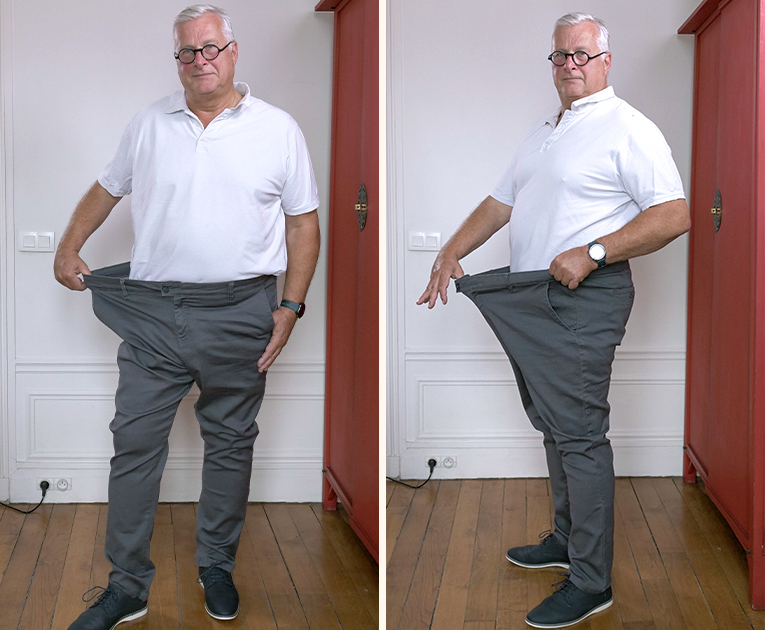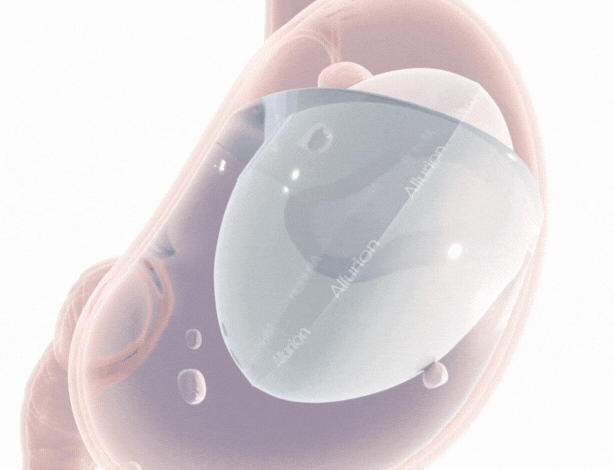
The Allurion Program
Clinically proven to help patients lose 10–15%* of their total body weight in just 4 months**. No surgery, no endoscopy, no anaesthesia.
Find your path to effective weight management
Obesity is complex. Your solution shouldn’t be.
Obesity isn’t a failure of willpower. It’s a chronic condition influenced by biology, environment, and behaviour.
That’s why we built the Allurion Program: the world's first and only swallowable gastric balloon combined with expert nutrition support and comprehensive digital tools. It's clinically proven, easy to get started with, and designed to deliver safe and lasting metabolically healthy weight loss.
We're setting the new standard of obesity care - inspiring, enabling, and empowering patients to transform their lives, for good.
Ready to take the 1st step?

Already partnering with Allurion? Access clinical protocols, patient dashboards and support tools to deliver best-in-class care.
Interested in joining our network? Learn how the Allurion Program can help you offer safe, effective and non-invasive weight loss to your patients. Become part of the the new standard of obesity care today.

Download the Allurion App to track your progress, connect your devices and access support—all in one place. Browse patient guides, troubleshoot issues or contact our team directly.
Trusted by over 180,000 patients around the world

“So far, I have lost 2.7 stone thanks to the Allurion Balloon. It wasn’t an easy decision, but when I think about it, it was the best decision I could have made"

"When I first came across Allurion, it was a game-change moment. In 20 min, you walk out and potentially your life is changed."

"I advise you to start today. Do not wait for tomorrow or the day after tomorrow. Because now is the time to do something before it's too late."

“Allurion has helped me to change my mindset on what I should eat. It has enabled me to carry out everyday tasks and given me my life back.”
As with any medical solution, results may vary from patient to patient, and some individuals may not respond to the treatment. Please consult a doctor to assess the risks and benefits before making your decision.
Stay up to date
with the latest news from Allurion, including press releases, media coverage, and multimedia content.
Got questions? We’ve got answers.
From how the Allurion Program works to clinical access, get the facts on the world’s first procedureless gastric balloon and digital care ecosystem.
We’re delighted to share that the NHS is considering our safe, non-surgical weight-loss solution. Presently, access to the Allurion Programme on the NHS is limited to specific patients in one trust in the UK. For individuals who wish to undergo this non-surgical weight-loss procedure, it is available as a private service at Allurion accredited clinics throughout the country. Click here for a complimentary consultation with a weight-loss advisor or here to use our Clinic Locator to find a clinic close to you.
The gastric balloon is a medical device designed to assist with weight loss. It is a soft balloon filled with liquid or air that is placed in the stomach. All gastric balloons have the same mechanism of action to occupy space, promoting a feeling of fullness and reducing food intake4. They typically remain in the stomach for several months before being removed by endoscopy or, in the case of the Allurion Balloon, naturally eliminated.**
We understand that swallowing the capsule containing the Allurion Balloon may worry some people, particularly due to the gag reflex.
A clinical study conducted with 1,770 patients showed that 99.9% of patients were able to swallow the capsule. Only one patient was unable to swallow the device. In 35.9% of cases, patients required assistance from a stylet to facilitate ingestion1. In such instances, the doctor helped by gently guiding the capsule down using the stylet, which helps to stiffen the catheter.
After approximately 4 months inside your stomach, a time-activated release valve will open, allowing the balloon to empty and pass naturally through the gastrointestinal tract without the need for a removal procedure.4*
Curious about the specifics of the Allurion Balloon removal? Dive into this detailed exploration on what the process involves.
We understand that weight regain after balloon passage is a common fear and source of anxiety. This is why the Allurion Balloon is accompanied by nutritional coaching and medical support to help you change your lifestyle and develop a healthier routine. Once the Allurion Balloon is out of your body, the support from your follow-up team continues until the end of the Allurion Programme to help you maintain the same eating habits.
The Allurion Balloon is placed in the stomach during an outpatient consultation.4 The patient swallows a capsule containing the deflated balloon, which is attached to a thin tube (catheter). Once the presence of the capsule in the patient’s stomach is confirmed (by X-ray), the balloon is filled with liquid using the catheter. A second X-ray is performed to ensure that the balloon is properly filled. The procedure is then complete, and the catheter is gently removed. In the majority of cases, approximately 4 months later, the Allurion Balloon empties on its own and is naturally eliminated.4**
Clinical evaluation of the Allurion Device suggests that on average, patients will lose approximately 10-15% of their starting total body weight4. Individual results vary widely.
If weight loss achieved is less than desired and the patient still qualifies and is not contraindicated, a sequential Allurion Device may be placed.
As with any medical solution, results may vary from patient to patient, and some may not respond to the treatment. Please consult a doctor to assess the risks and benefits before making your decision.
GLP-1s can play a valuable role in weight management, but only as part of a comprehensive approach. The Allurion Program reframes how patients engage with food and their health - combining appetite regulation with fullness training, behaviour change and personalised support.
Our goal is to shift the conversation from how much weight is lost to what kind of weight is lost, and how health is improved. By combining our procedureless gastric balloon, connected digital tools, AI coaching and clinician-led care, we’re setting a new standard for obesity treatment.
Our programme acts as the central pillar to any program, working effectively alongside other treatments like surgery, weight loss pills, and GLP-1 jabs. With GLP-1s, we are pioneering a low dose combination approach that not only enhances weight loss but also preserves and builds lean body mass.
Early data shows patients using Allurion with low-dose GLP-1s achieved up to 20% total weight loss and a 15% increase in muscle mass in just eight months. That’s what metabolically healthy weight loss looks like.
Metabolically healthy weight loss is about more than the number on the scale. It focuses on long-term fat loss, muscle preservation, and improvements to overall metabolic health, including blood sugar regulation, energy levels and reduced risk of chronic disease.
Weight loss, weight maintenance and muscle gain must go hand in hand. That’s why the Allurion Program supports fat reduction while helping patients retain lean muscle mass and build sustainable habits for life.
Important information to consider before the placement of an Allurion Gastric Balloon
- The Allurion Balloon is a regulated health product that bears the CE marking in accordance with this regulation. To learn more about the Allurion Balloon, assess the risks and benefits of this solution, read the important safety information, and discuss it with your doctor. Learn more
- The Allurion Gastric Balloon is part of a behaviour modification programme that lasts for a minimum of 6 months, to which you must be fully committed. This device is designed to promote weight loss, but only by committing to changing your eating habits and increasing your physical activity will you be able to achieve and maintain a healthy weight in the long term.
- It is important to note that the Allurion Gastric Balloon may cause adverse events, some of which may require removal by endoscopy. Rare cases of spontaneous hyperinflation, small intestine obstruction, stomach dilation, oesophagitis, pancreatitis, or stomach perforation have been reported, requiring surgical intervention.1,4 Please consult the full list of potential complications available on the page Important Safety Information.
- The Allurion Gastric Balloon is not suitable for all patients. Pregnant individuals or those with a history of oesophageal or stomach surgery, among others, are not eligible for the procedure. The complete list of contraindications can be found in the device's instructions for use provided to doctors. Your doctor will review your medical history and conduct a physical examination to confirm your eligibility for the Allurion Programme.
- It is crucial that each doctor and patient carefully assess the risks and benefits of the treatment before using the Allurion device. To learn more about the Allurion Balloon, its effectiveness, and its tolerability, discuss it with your doctor.
- You must be available for follow-up with your doctor throughout the treatment period, especially if you experience the following symptoms, including but not limited to: persistent nausea, vomiting, dehydration, and/or abdominal pain. If you consult other healthcare professionals, inform them that an intragastric balloon is present. We encourage you to stay close to modern emergency care facilities during the time the balloon is in place, in case serious complications arise.






